 |
|
Hi, you're in the Archives, November 2008 - Part 2 |
|
|
|
|
 |
| |
|
November
30, 2008 |
|
 |
THIS
JUST IN!
A TRUE STORY, AS TOLD AND ILLUSTRATED
BY WHISKYFUN'S CORRESPONDENT IN ZAGREB,
CROATIA |
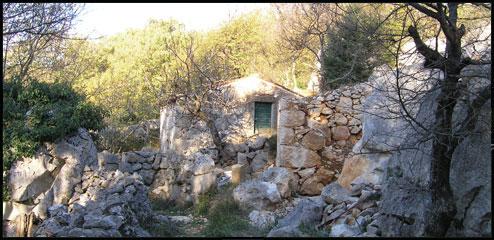 |
| Just
after Louis-Vuitton-Moët-Hennessy
acquired Ardbeg Distillery, their
marketing directors started to wonder
why no Ardbeg single malt was ever
sold to a market as large as Croatia.
Therefore they hired a well-trained
and well-known detective named Igor
to investigate the matter. After a
long and hard search Igor found out
that at a remote place called Filozici,
on the remote island of Cres
that lies in a remote sea called the
Adriatic, operated a man called Dr.
Know (pronounced dr:nou), a man who
was very much loved by the locals.
The reason for that is that Dr. Know
produced a spirit called ‘Ardbeg’
that everybody there just adored. |
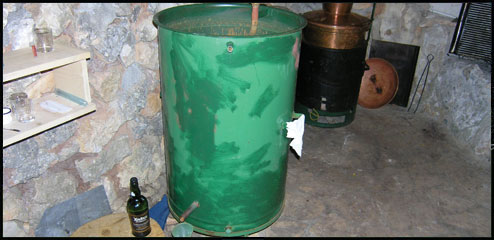 |
| With
the help of the intuition, Igor found
out that in the hidden cottage, a
very complicated machinery had been
built, which was capable of producing
millions of bottles of Ardbeg on a
daily basis. |
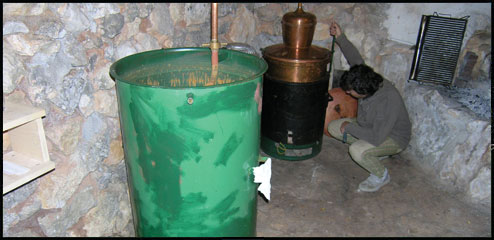 |
| Igor
immediately measured the heighth of
the spirit still, finding it to be
the tallest on the island. That was
the reason why such a sophisticated
and successful spirit was produced. |
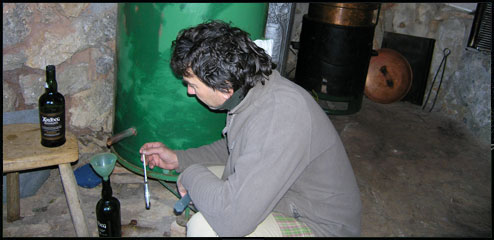 |
| Igor
also measured the strength of the
spirit that was running directly out
of the condenser (105% pure ethyl!),
as well as the strength at which it
was then immediately bottled: 52.3%
vol. |
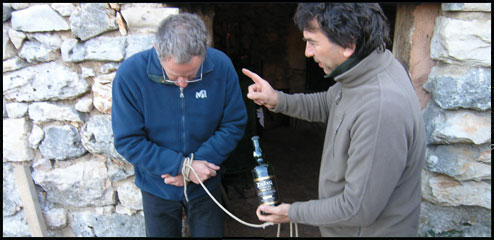 |
| But
Dr. Know was soon to show up round
the corner and was immediately arrested.
Igor found out that the moonshiner’s
real name was Tomislav, a man with
very good connections in France, Italy,
Germany, Canada and Islay. |
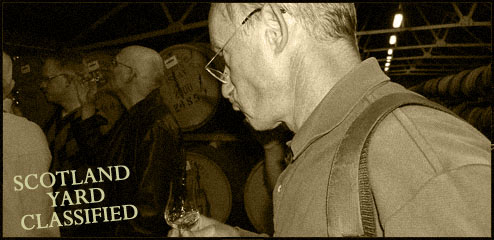 |
| It
was also found out that Tomislav had
been spying on the original distillery
for a long time and had learned about
how to make such brilliiant spirit
during his numerous visits to Islay
(picture from Scotland Yard's
Archives: the man caught spying in
one of Ardbeg's warehouses). |
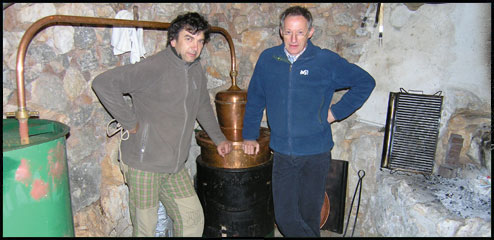 |
| But
the story ends well. Igor made a fatal
mistake when he decided to try the
Croatian Ardbeg and all at once he
forgot his duties and instantly became
friend with Tomislav. The two fellows
subsequently decided to send a wee
sample of the Croatian Ardbeg to a
famous whisky writer in the U.K.,
who awarded it with the title of ‘World
Whisky of the Year’ after having
scored it 97.5 points out of 100!
The only little mistake that Igor
and Tomislav had made was to write
the origin of the spirit too quickly
on the sample’s label, so one
may well have have read ‘Canada’
instead of ‘Croatia’.
They had also written 'Uiggidill',
which means 'whisky' in Cressian dialect. |
| |
|
November
28, 2008 |
|
 |
| MALT
MANIACS NEWSFLASH
The
first results of the Malt
Maniacs Awards 2008 are in!
On
Malt
Maniacs of course! |
 |
|
| CONCERT
REVIEW by Nick Morgan |
| THE
FLEET FOXES
Shepherds Bush Empire
London
November 5th 2008 |
 |
| Few
new bands can have earned such plaudits
over the past year as Seattle five-piece
The
Fleet Foxes, whose eponymous
album (released in June) found dewy-eyed
reviewers looking back forty years
with unwarranted affection to the
great summer of love, whose soundtrack
has so clearly inspired composer Robin
Pecknold and his colleagues. |
| These
hugely talented young men, (the five-piece
which recorded the album subsequently
lost two members and gained a couple
more, including drummer J
Tillman, who played a largely
unappreciated acoustic solo support
set here), with their unruly hair,
unkempt beards and nonchalantly-worn
shabby clothes, exude the spirit of
the sixties. Their conceit is that
of the purist, the enthusiast, the
gifted amateur, the searcher for truth
and beauty rather than fame and fortune
– ‘not much of a rock
band’ as they describe themselves.
And according to the press, the band
and their various family members live
the sort of idyllic, almost communal
life style, that those reviewers harking
back to a lost golden age (and no
doubt a lost youth too) might wish
for themselves. Why, even their merchandise
store turns its back on merchandise,
preferring to offer ‘artefacts’
for sale instead. Tell me Serge –
since when has a t-shirt been an artefact? |
| The
Shepherds Bush Empire is packed to
the rafters (a lot of the audience
sporting unruly hair, unkempt beards
and nonchalantly-worn shabby clothes)
and there is an air of eager, if uncertain,
expectation. But whatever the preconceptions,
the whole place is blown away by an
enchanting start, with the unaccompanied
‘Sun Giant’ followed by
album opener ‘The sun it rises’,
a song caught somewhere between Steeleye
Span’s English idyll, and the
unabashed and joyful audacity of ‘Suite
Judy blue eyes’ (do you remember
just how remarkable that sounded played
for the first – or was it second
– time at Woodstock?). These
boys can sing. It’s not just
Pecknold, whose voice must be a recording
technician’s dream (and an A&R
man’s for that matter) but the
whole band. We’ve already heard
Tillman’s delicate high-notes,
but combined with Pecknold and his
colleagues the impact is stunning.
However I do get a growing sense of
déjà vu as the evening
wears on – and realise I’m
not thinking back even a few decades
but rather a few months. Same theatre,
different band. It was the Zombies
in March playing the famously miss-spelt
Odessey and Oracle, “a piece
now regarded as a landmark album –
straddling the Beach Boys and Brian
Wilson on the one hand and the Beatles
and Lennon and McCartney (sorry Sir
Paul, I mean McCartney and Lennon)
on the other”. And sadly, once
that thought got into my mind (not
the Sir Paul bit I hasten to add)
it unleashed a small wave of negativity
which I found difficult to lose as
the evening progressed – sadly
quite the reverse. And the Photographer
was no help – after about 15
minutes, frustrated at not getting
a good shot, she had firmly adopted
the ‘I’m a bored Photographer
get me out of here’ look. |
| So
before Whiskyfun is hacked out of
existence by starry-eyed naive and
idealistic, unruly hair, unkempt beard
and nonchalantly-worn shabby clothes-sporting
youths, let me repeat how good these
guys are, they can play, and as I’ve
said, they sing like angels (Pecknold
singing Judee Sill’s ‘Crayon
Angels’ and ‘Oliver James’
solo was spine-tinglingly good). They’re
also quite personable. Anyone who
comes on to the stage the day after
an American Presidential Election
and says “You know, this is
the first time I’ve walked on
stage and not felt bad about being
American” has to win a small
place in your heart for their candour
alone. And their radio style chit-chat
about politics and all that sort of
stuff is insouciantly charming. And
I did mention they could sing, didn’t
I? |
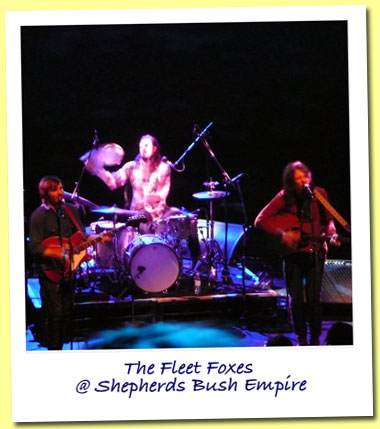 |
But
the sad fact is they’re all
source material and no synthesis.
There’s no real argument here
– no hypothesis. I’m not
saying it’s plagiarism –
it’s so much better than that,
but these boys have got a long way
to go before they’re the real
deal. The songs are episodic –
almost incomplete. And the lyrics
– well if you’ve got a
mind open to the realities of the
world we live in, then you have to
wonder where they could have come
from – if not, of course, from
Odessey and Oracle and its like. |
| And
you just can’t write songs and
keep your head totally in the sand,
as some reviewers would seem to wish.
But I would like to think that the
Fleet Foxes, and their genius Mr Pecknold,
do have a truly great album inside
them somewhere. And I’ll be
the first to buy it. |
| In
the meantime, here’s a nice
idea for anyone struggling to decide
how to spend their VAT cuts and tax
rebates, as the fall of world capitalism
brings Christmas strangely closer.
This is an after-Christmas-lunch game,
for adults only, involving a blindfold
and a copy of the Fleet Foxes very
nice album, and a copy of the Zombies
Odessey
and Oracle (Revisited), recorded
live at the Bush this year. (If you
listen closely you might hear a gentle
Fender amplifier hum in the background,
but rest assured it was only the Photographer
snoring gently). Get your DJ to alternate
tracks and try and guess which is
which. Hours of fun and seasonal obfustication
guaranteed.
- Nick Morgan (concert polaroids by
Kate and Nick) |
| Listen:
The
Fleet Foxes' MySpace page |
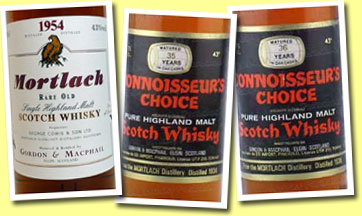 |
TASTING
THREE
VERY OLD MORTLACHS by G&M |
| Mortlach
1954/2008 (43%, Gordon & MacPhail,
licensed bottling)
 If I’m not mistaken, this
one is 54 years old, more or less!
Colour: amber. Nose: it seems that
this one is very well alive after
all these years! Of course it’s
not a restless youngster anymore
but it displays most of the very
subtle aromas that one would expect
from such an oldie, starting with
milk chocolate and balsamic vinegar,
beeswax, old wooden furniture, leather,
roasted nuts and ‘old liqueurs’
and ending up with verbena, old
tea, dried mint, various other herbs
and old Burgundy wine (game). Much
more coffee after ten minutes –
actually, it does smell like plain
coffee! Mouth: hey-hey, it’s
almost restless! Very concentrated,
creamy, sweet and fruity (bananas
flambéed), with notes of
old Cognac (these spirits do start
to taste almost the same when they
are very old) and old rum (ditto).
It’s also a little almondy,
getting finally more and more resinous
and herbal (tannins). Notes of old
sherry too. Finish: long, more on
‘old’ jams. Fig jam?
Comments: there is quite some wood
in this one but the spirit was big
in the first place and stood the
oak. Maybe not totally stunning
but the fact that it’s still
so much alive after all these years
is an achievement as such. SGP:471
– 86 points.
If I’m not mistaken, this
one is 54 years old, more or less!
Colour: amber. Nose: it seems that
this one is very well alive after
all these years! Of course it’s
not a restless youngster anymore
but it displays most of the very
subtle aromas that one would expect
from such an oldie, starting with
milk chocolate and balsamic vinegar,
beeswax, old wooden furniture, leather,
roasted nuts and ‘old liqueurs’
and ending up with verbena, old
tea, dried mint, various other herbs
and old Burgundy wine (game). Much
more coffee after ten minutes –
actually, it does smell like plain
coffee! Mouth: hey-hey, it’s
almost restless! Very concentrated,
creamy, sweet and fruity (bananas
flambéed), with notes of
old Cognac (these spirits do start
to taste almost the same when they
are very old) and old rum (ditto).
It’s also a little almondy,
getting finally more and more resinous
and herbal (tannins). Notes of old
sherry too. Finish: long, more on
‘old’ jams. Fig jam?
Comments: there is quite some wood
in this one but the spirit was big
in the first place and stood the
oak. Maybe not totally stunning
but the fact that it’s still
so much alive after all these years
is an achievement as such. SGP:471
– 86 points. |
Mortlach
35 yo 1936 (43%, Gordon & MacPhail
for Pinerolo, rotation 1972)
 35 years in wood plus 35 years in
glass, this should be close to perfection!
Colour: full gold. Nose: we’re
on another planet here! Totally exceptional,
in the same league as very old Yquems
and other old white wines of the highest
grades. Let’s not be too long
(the anti-maltoporn brigade may be
watching), this is fantastically ‘phenolic’,
herbal, waxy, sooty and fruity - and
immensely complex. Mouth: a miracle.
All the fruits (okay, mainly dates,
quinces and figs), all the nuts (macadamia
first, very obvious here), all the
‘resins and oils’ and
probably hundreds of tiny other flavours,
many not even known to Man (don’t
get carried away, S.!) Amazing presence,
it’s only after a good twenty
minutes that it starts to show signs
of relative tiredness, which is totally
normal of course. Finish: not too
long but so complex! It’s the
leathery and sooty part that’s
the most active at this point. Comments:
a poem. I think it’s a dimension
that you just can’t achieve
with only wood maturing, and I believe
that some Scots should try to create
‘paradises’ like they
have at their best enemies’
the Cognac houses. Even if that may
costs them quite some years on the
labels (non-wood years don’t
count). Who will try that first? After
all, that’s what The Macallan
sort of did with their Fine and Rare
series - many being rebottled old
G&Ms just like this Mortlach –
and a Macallan 1926 Fine and Rare
was just sold for USD 70,000 in South
Korea this year! SGP:552 –
96 points.
35 years in wood plus 35 years in
glass, this should be close to perfection!
Colour: full gold. Nose: we’re
on another planet here! Totally exceptional,
in the same league as very old Yquems
and other old white wines of the highest
grades. Let’s not be too long
(the anti-maltoporn brigade may be
watching), this is fantastically ‘phenolic’,
herbal, waxy, sooty and fruity - and
immensely complex. Mouth: a miracle.
All the fruits (okay, mainly dates,
quinces and figs), all the nuts (macadamia
first, very obvious here), all the
‘resins and oils’ and
probably hundreds of tiny other flavours,
many not even known to Man (don’t
get carried away, S.!) Amazing presence,
it’s only after a good twenty
minutes that it starts to show signs
of relative tiredness, which is totally
normal of course. Finish: not too
long but so complex! It’s the
leathery and sooty part that’s
the most active at this point. Comments:
a poem. I think it’s a dimension
that you just can’t achieve
with only wood maturing, and I believe
that some Scots should try to create
‘paradises’ like they
have at their best enemies’
the Cognac houses. Even if that may
costs them quite some years on the
labels (non-wood years don’t
count). Who will try that first? After
all, that’s what The Macallan
sort of did with their Fine and Rare
series - many being rebottled old
G&Ms just like this Mortlach –
and a Macallan 1926 Fine and Rare
was just sold for USD 70,000 in South
Korea this year! SGP:552 –
96 points. |
Mortlach
36 yo 1936 (43%, Gordon & MacPhail
for Pinerolo, rotation 1973)
 Colour: full gold. Nose: this
is not quite the same whisky, as it’s
a little less fresh and rather nuttier
and more chocolaty. It’s less
sooty/waxy too, and a tad less complex.
A bigger OBE as well. Anyway, brilliant
whisky again, just a ‘slightly
subdued variation’ on the 35yo.
Mouth: exactly the same happens on
the palate. Same differences, without
exceptions. Finish: ditto. Comments:
another magical old Mortlach from
the golden years. Isn’t it strange
that while Europe was preparing for
one of the worst wars ever, some distilleries
such as Macallan, Linkwood, Mortlach
or Talisker were distilling the best
whiskies ever made by Man (and computers
of course – pfff…)? SGP:443
- 91 points.
Colour: full gold. Nose: this
is not quite the same whisky, as it’s
a little less fresh and rather nuttier
and more chocolaty. It’s less
sooty/waxy too, and a tad less complex.
A bigger OBE as well. Anyway, brilliant
whisky again, just a ‘slightly
subdued variation’ on the 35yo.
Mouth: exactly the same happens on
the palate. Same differences, without
exceptions. Finish: ditto. Comments:
another magical old Mortlach from
the golden years. Isn’t it strange
that while Europe was preparing for
one of the worst wars ever, some distilleries
such as Macallan, Linkwood, Mortlach
or Talisker were distilling the best
whiskies ever made by Man (and computers
of course – pfff…)? SGP:443
- 91 points. |
| |
|
November
27, 2008 |
|
 |
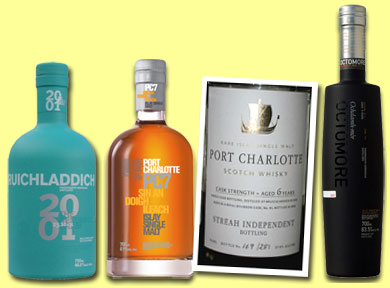
|
TASTING
THE 'NEW NEW' LADDIES |
| We
really do admire how the Bruichladdich
crew managed to improve the brand’s
fame and image and to increase ‘to
the max’ the value of the dowry
of thousands of casks they got when
they bought the distillery in the
very early 2000s – not that
there weren’t quite a few straight
gems as well within the bunch, of
course! But now is the time to try
their three brand new ‘100%
original’ bottlings, all fully
made by the gang, in their naked glory
(the whiskies, not the gang…) |
Bruichladdich
2001/2008 ‘Resurrection’
(46%, OB, bourbon, 24,000 bottles)
 From the first runs of Bruichladdich
by the new owners, using malt that
was peated to 10ppm before they went
back to very little peat after that.
It seems that there were also batches
at other peat levels (we’ve
also seen 5 or 8). The bottle itself
is very, say ‘noticeable’
and the name of 'Resurrection' rings
a bell (Renaissance, anyone? Who will
launch a Rebirth? ;-)) Colour: pale
gold. Nose: what strikes first is
the peat, quite unexpectedly. It’s
as if Bruichladdich’s trademark
freshness and cleanliness worked as
an amplifier for the tiniest ‘ppms’.
The peat calms down after a while,
that is, leaving room for quite some
iodine and even medicinal hints (unexpected
again), as well as notes of fresh
mint and aniseed. It’s also
quite farmy in the background (farmyard,
hay, wet wool). Very little sweetness
and fruitiness here and in that sense
it’s extremely different from
older ‘natural’ versions
that always had a little apple/pear/peach/melon/you
name it. After ten minutes: a lot
of smoke and elements from the sea
(make that sea air). Mouth: once again,
this is very surprising, much peatier
than expected. Very ‘maritime’
again (oysters!) and rather herbal
and spicy (mint, green tea, ginger,
white pepper.) Quite ashy/smoky as
well. Hints of bitter fruits developing
(cider apples) as well as chlorophyll
but the peatiness is still unexpectedly
huge. Finish: long, smoky and vegetal
(Japanese green tea). Comments: a
huge surprise. This has strictly nothing
to do with the older 10 or 15yo, whether
recent or formerly bottled by Invergordon
or earlier owners. It has to be ranked
among the peated Islayers –
not the monsters of course -, even
if it does also have something of
Scotland’s northeastern coast.
By the way, we like it a lot. SGP:255
- 87 points.
From the first runs of Bruichladdich
by the new owners, using malt that
was peated to 10ppm before they went
back to very little peat after that.
It seems that there were also batches
at other peat levels (we’ve
also seen 5 or 8). The bottle itself
is very, say ‘noticeable’
and the name of 'Resurrection' rings
a bell (Renaissance, anyone? Who will
launch a Rebirth? ;-)) Colour: pale
gold. Nose: what strikes first is
the peat, quite unexpectedly. It’s
as if Bruichladdich’s trademark
freshness and cleanliness worked as
an amplifier for the tiniest ‘ppms’.
The peat calms down after a while,
that is, leaving room for quite some
iodine and even medicinal hints (unexpected
again), as well as notes of fresh
mint and aniseed. It’s also
quite farmy in the background (farmyard,
hay, wet wool). Very little sweetness
and fruitiness here and in that sense
it’s extremely different from
older ‘natural’ versions
that always had a little apple/pear/peach/melon/you
name it. After ten minutes: a lot
of smoke and elements from the sea
(make that sea air). Mouth: once again,
this is very surprising, much peatier
than expected. Very ‘maritime’
again (oysters!) and rather herbal
and spicy (mint, green tea, ginger,
white pepper.) Quite ashy/smoky as
well. Hints of bitter fruits developing
(cider apples) as well as chlorophyll
but the peatiness is still unexpectedly
huge. Finish: long, smoky and vegetal
(Japanese green tea). Comments: a
huge surprise. This has strictly nothing
to do with the older 10 or 15yo, whether
recent or formerly bottled by Invergordon
or earlier owners. It has to be ranked
among the peated Islayers –
not the monsters of course -, even
if it does also have something of
Scotland’s northeastern coast.
By the way, we like it a lot. SGP:255
- 87 points. |
Port
Charlotte 2001/2008 ‘PC7’
(61%, OB, American oak, 24,000 bottles)
 PC5 was youthful and fruity (86) and
PC6 was bigger and fuller but also
just a tad winey on the nose as it
spent some time in Madeira casks (88).
Greatest of news, PC7 is ‘more
traditionnal’, that is to say
partly bourbon and partly sherry matured
(thanks Arild). Colour: gold. Nose:
much more spirity than the Laddie
of course, thanks to the very high
alcohol. We do get coffee (as often
in high-strength whiskies), pears
and smoke but that’s pretty
all. Nothing unusual, let’s
add water… With water: now we’re
talking! Extremely organic, all estery
notes having vanished, with a big
smokiness and big both farmy and coastal
notes (from wet dogs to clams –
excuse us dogs and clams). Also quite
some freshly ground black pepper,
walnuts and just hints of car dashboard
polish. Mouth (neat): strong, very
strong. Fructose, salt and apple peeling
but that’s all. With water:
the peat and the smokiness are very
big now, almost a bit acrid. The whole
is much less fruity than PC5 and 6
but also better integrated, with also
more salt and just hints of butter
pears. Finish: very long, peaty, liquoricy
and a tad gingery. Comments: it is
extremely clean and rather fat at
the same time. It’s probably
a little less exuberant than PC6 but
also ‘sleeker’ in a certain
way. Which we appreciate mucho! SGP:247
- 89 points.
PC5 was youthful and fruity (86) and
PC6 was bigger and fuller but also
just a tad winey on the nose as it
spent some time in Madeira casks (88).
Greatest of news, PC7 is ‘more
traditionnal’, that is to say
partly bourbon and partly sherry matured
(thanks Arild). Colour: gold. Nose:
much more spirity than the Laddie
of course, thanks to the very high
alcohol. We do get coffee (as often
in high-strength whiskies), pears
and smoke but that’s pretty
all. Nothing unusual, let’s
add water… With water: now we’re
talking! Extremely organic, all estery
notes having vanished, with a big
smokiness and big both farmy and coastal
notes (from wet dogs to clams –
excuse us dogs and clams). Also quite
some freshly ground black pepper,
walnuts and just hints of car dashboard
polish. Mouth (neat): strong, very
strong. Fructose, salt and apple peeling
but that’s all. With water:
the peat and the smokiness are very
big now, almost a bit acrid. The whole
is much less fruity than PC5 and 6
but also better integrated, with also
more salt and just hints of butter
pears. Finish: very long, peaty, liquoricy
and a tad gingery. Comments: it is
extremely clean and rather fat at
the same time. It’s probably
a little less exuberant than PC6 but
also ‘sleeker’ in a certain
way. Which we appreciate mucho! SGP:247
- 89 points. |
‘Intermediate
bonus’ - another PC for good
measure: Port
Charlotte 6 yo 2002/2008 (57.6%, Streah,
cask #85, 281 bottles)
 Streah is a new small indie bottler.
It seems that they have only bottled
this PC so far. Colour: straw. Nose:
this one is easier to nose when undiluted.
It’s a tad less smoky as well
as fruitier than the PC7, with more
‘direct’ coastal notes
(seaweed). More notes of tincture
of iodine and vanilla as well. With
water: the difference is exactly the
same. More fruits (pears, apples,
gooseberries) and more ‘fresh’
notes (kelp, grass, fresh walnuts.)
Less smoke. Mouth (neat): extremely
close to the PC7, almost as strong,
with a bigger smokiness this time.
With water: we’re extremely
close to the PC7 again. Maybe just
a tad fruitier again, and maybe also
a tad more peppery and less ‘fat’.
Finish: long, clean, really half-peaty
half-fruity (green apples), with a
very peppery aftertaste. Comments:
one year younger than the PC7 and
one can feel that from the added fruitiness.
But it’s great whisky anyway.
SGP:347 - 87 points.
(and thank you, Tomislav)
Streah is a new small indie bottler.
It seems that they have only bottled
this PC so far. Colour: straw. Nose:
this one is easier to nose when undiluted.
It’s a tad less smoky as well
as fruitier than the PC7, with more
‘direct’ coastal notes
(seaweed). More notes of tincture
of iodine and vanilla as well. With
water: the difference is exactly the
same. More fruits (pears, apples,
gooseberries) and more ‘fresh’
notes (kelp, grass, fresh walnuts.)
Less smoke. Mouth (neat): extremely
close to the PC7, almost as strong,
with a bigger smokiness this time.
With water: we’re extremely
close to the PC7 again. Maybe just
a tad fruitier again, and maybe also
a tad more peppery and less ‘fat’.
Finish: long, clean, really half-peaty
half-fruity (green apples), with a
very peppery aftertaste. Comments:
one year younger than the PC7 and
one can feel that from the added fruitiness.
But it’s great whisky anyway.
SGP:347 - 87 points.
(and thank you, Tomislav) |
Octomore
5 yo ‘Edition 01.1’ (63.5%,
OB, bourbon, 6,000 bottles, 2008)
 Here it is, the frightening peat monster
that was distilled out of malt that
was peated to 131ppm (whilst the ‘Futures’
used malt peated to 80ppm). Everybody
knows that ppms in the barley and
ppms in the spirit aren't the same
thing and that one may lose a huge
proportion of the peatiness during
the mashing/brewing/distilling process,
but still, 131! Unusual bottle too!
Colour: straw. Nose: once again, it’s
a bit hard to get many aromas from
such high strength but the first overall
sensation I have is ‘an ashtray
full of cigar ash at four in the morning’
plus quite some olive oil. With water:
a maelstrom of kerosene, diesel oil,
tar, fermenting grass, canned sardines
and even anchovies. And both the habanos
and the olive oil are still there.
The only possible comparison with
other ‘general profiles’
would be with ‘old young’
Ardbegs such as the 10yos white label.
Mouth (neat): very, very unusual!
The peat is extremely big, even at
full strength, and you get almost
the same flavours as when you chew
raw peated malt. Other than that there’s
some other ‘stuff’ (fruits
and such) but I feel it’s too
dangerous to go any further without
bringing this baby down to roughly
45% (Serge, you sissy!). With water:
an immense smokiness, notes of pipe
juice, salmiak, Japanese oyster sauce,
mastic, walnut skin and ultra-dry
fino sherry (yes we know this one
didn’t mature in sherry casks.)
Finish: long, extremely tarry and
liquoricy, with a little salt –
or rather a saltiness. Comments: good,
one may have thought that after all
the fuss, this unusual whisky may
have brought nothing but shrugs and
disappointments. But truth is that
this is a very impressive beverage,
both very spectacular and extremely
good, far from being only a peat record
breaker. As Jean de la Fontaine would
have said, this garage whisky has
got ‘le ramage et le plumage’
(both warbling and plumage.) The new
Le Pin of the whisky world? SGP:249
– 89 points. (I’m
sure Octomore will fetch 90+ points
within only a few years, maybe even
one single year, but of course you
have to be a peatophile to enjoy this.
Now, who isn't these days?)
Here it is, the frightening peat monster
that was distilled out of malt that
was peated to 131ppm (whilst the ‘Futures’
used malt peated to 80ppm). Everybody
knows that ppms in the barley and
ppms in the spirit aren't the same
thing and that one may lose a huge
proportion of the peatiness during
the mashing/brewing/distilling process,
but still, 131! Unusual bottle too!
Colour: straw. Nose: once again, it’s
a bit hard to get many aromas from
such high strength but the first overall
sensation I have is ‘an ashtray
full of cigar ash at four in the morning’
plus quite some olive oil. With water:
a maelstrom of kerosene, diesel oil,
tar, fermenting grass, canned sardines
and even anchovies. And both the habanos
and the olive oil are still there.
The only possible comparison with
other ‘general profiles’
would be with ‘old young’
Ardbegs such as the 10yos white label.
Mouth (neat): very, very unusual!
The peat is extremely big, even at
full strength, and you get almost
the same flavours as when you chew
raw peated malt. Other than that there’s
some other ‘stuff’ (fruits
and such) but I feel it’s too
dangerous to go any further without
bringing this baby down to roughly
45% (Serge, you sissy!). With water:
an immense smokiness, notes of pipe
juice, salmiak, Japanese oyster sauce,
mastic, walnut skin and ultra-dry
fino sherry (yes we know this one
didn’t mature in sherry casks.)
Finish: long, extremely tarry and
liquoricy, with a little salt –
or rather a saltiness. Comments: good,
one may have thought that after all
the fuss, this unusual whisky may
have brought nothing but shrugs and
disappointments. But truth is that
this is a very impressive beverage,
both very spectacular and extremely
good, far from being only a peat record
breaker. As Jean de la Fontaine would
have said, this garage whisky has
got ‘le ramage et le plumage’
(both warbling and plumage.) The new
Le Pin of the whisky world? SGP:249
– 89 points. (I’m
sure Octomore will fetch 90+ points
within only a few years, maybe even
one single year, but of course you
have to be a peatophile to enjoy this.
Now, who isn't these days?) |
|
MUSIC
– Recommended
listening: French bassist Henri
Texier and his supernatural
gang (Lee Konitz, Bob Brookmeyer,
Steve Swallow, Paul Motian - what
a line-up!) play Respect.mp3
in 1998. I say respect! Please buy
Henri texier's music... |
 |
| |
|
November
26, 2008 |
|
 |
| PETE
McPEAT AND JACK WASHBACK |
| TASTING
– FIVE NEW TOMATINS (a short
verticale) |
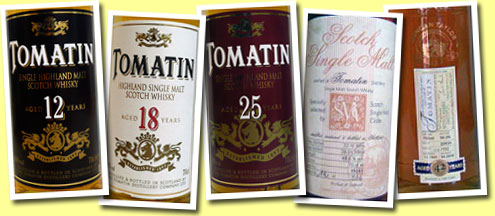 |
Tomatin 12 yo (40%, OB, Bottled +/-
2008)  Colour: straw. Nose: light, very fresh,
all on apple juice, strawberries,
light honey and cereals. A perfect
breakfast malt? Cleaner than earlier
batches in my opinion. Good news!
Mouth: clean, fruity and grainy but
lacking oomph and complexity at this
point. Something roasted and rather
malty but we’re in ‘blended’
territories here (if that makes any
sense). Finish: medium-long, malty
and ‘simply’ honeyed.
Comments: a very pleasant nose but
a palate that’s still a bit
too mundane for our taste (how pretentious
is that?) SGP:320 - 77 points.
Colour: straw. Nose: light, very fresh,
all on apple juice, strawberries,
light honey and cereals. A perfect
breakfast malt? Cleaner than earlier
batches in my opinion. Good news!
Mouth: clean, fruity and grainy but
lacking oomph and complexity at this
point. Something roasted and rather
malty but we’re in ‘blended’
territories here (if that makes any
sense). Finish: medium-long, malty
and ‘simply’ honeyed.
Comments: a very pleasant nose but
a palate that’s still a bit
too mundane for our taste (how pretentious
is that?) SGP:320 - 77 points. |
Tomatin
18 yo (40%, OB, Bottled +/- 2008)
 A recent version that I never tried
before. Colour: straw. Nose: very
nice nose! More complex than the 12,
much more flowery and honeyed. Unexpected
hints of smoke as well. Apple peeling,
fresh walnuts, grapes, hints of capsicum.
We like this a lot. Mouth: much richer
and more complex than the 12, woodier
as well. Jammy, with notes of apricots,
herbal tea (cherry stem), quince,
cough gums, pine resin… Almost
as nice as on the nose. Finish: rather
long for 40%, a tad earthier. ‘Good’
rubber. Comments: a surprise. Excellent
and worth any cent, which cannot be
said regarding all recent Scottish
bottlings, can it? SGP:441
- 86 points.
A recent version that I never tried
before. Colour: straw. Nose: very
nice nose! More complex than the 12,
much more flowery and honeyed. Unexpected
hints of smoke as well. Apple peeling,
fresh walnuts, grapes, hints of capsicum.
We like this a lot. Mouth: much richer
and more complex than the 12, woodier
as well. Jammy, with notes of apricots,
herbal tea (cherry stem), quince,
cough gums, pine resin… Almost
as nice as on the nose. Finish: rather
long for 40%, a tad earthier. ‘Good’
rubber. Comments: a surprise. Excellent
and worth any cent, which cannot be
said regarding all recent Scottish
bottlings, can it? SGP:441
- 86 points. |
Tomatin
25 yo (40%, OB, Bottled +/- 2008)
 Colour: pale gold. Nose: once again,
a very pleasant nose, more on the
fruity side this time. Tinned pineapples,
guavas, lavender honey (that does
not smell like lavender perfume, eh!),
tangerines, ripe bananas… I
always found kind of an Irishness
in older Tomatins and this one is
no exception. Mouth: rich, fruity,
lively. Excellent despite its low
strength. Very Irish once again. Bananas
flambéed and apple pie. Finish:
long, candied and fruity. Comments:
even more expressive than the 18 but
maybe a tad less complex. Anyway,
I really like these malts that are
so fairly priced – but not only
because of that. SGP:631 -
85 points.
Colour: pale gold. Nose: once again,
a very pleasant nose, more on the
fruity side this time. Tinned pineapples,
guavas, lavender honey (that does
not smell like lavender perfume, eh!),
tangerines, ripe bananas… I
always found kind of an Irishness
in older Tomatins and this one is
no exception. Mouth: rich, fruity,
lively. Excellent despite its low
strength. Very Irish once again. Bananas
flambéed and apple pie. Finish:
long, candied and fruity. Comments:
even more expressive than the 18 but
maybe a tad less complex. Anyway,
I really like these malts that are
so fairly priced – but not only
because of that. SGP:631 -
85 points. |
Tomatin
1976/2008 (49.6%, Scotch Single Malt
Circle, cask #19085, 336 bottles)
 Colour: amber. Nose:
almost the same overall profile as
the 25, only with more punch and added
herbal notes, ranging from pine resin
to dill. Also hints of fresh putty.
Extremely sexy! Mouth: very punchy
and very fruity but a little less
so than the official 25. The wood
is more present (tannins) and so are
the resinous notes. Green tea, cough
syrup, strawberry jam, heavy liquorice
and cinnamon. Gets maybe just a tad
too kirschy after a moment. Finish:
long, with also the same kind of rubberiness
as in the official 18. Comments: a
big fruity dram with quite some tannins
that give it a very solid structure.
SGP:661 - 88 points.
Colour: amber. Nose:
almost the same overall profile as
the 25, only with more punch and added
herbal notes, ranging from pine resin
to dill. Also hints of fresh putty.
Extremely sexy! Mouth: very punchy
and very fruity but a little less
so than the official 25. The wood
is more present (tannins) and so are
the resinous notes. Green tea, cough
syrup, strawberry jam, heavy liquorice
and cinnamon. Gets maybe just a tad
too kirschy after a moment. Finish:
long, with also the same kind of rubberiness
as in the official 18. Comments: a
big fruity dram with quite some tannins
that give it a very solid structure.
SGP:661 - 88 points. |
Tomatin
42 yo 1965/2008 (50.0%, Duncan Taylor
Rare Auld, Germany, cask #20939)
 Colour: gold. Nose: it’s quite
fantastic to be able to try this after
the 25 and the 1976, for it’s
really the ‘natural’ evolution
of them. The fruitiness got more complex
and maybe a little less wham-bam whilst
the spicy and resinous notes from
the wood got bigger. Cigar box, old
furniture, wax polish, pollen, bananas
flambéed, nougat… In
short, this is quite superb. Let’s
only hope that the palate won’t
be too woody and dry… Mouth:
super, it’s not woody at all,
rather extravagantly fruity, almost
bubblegummy. Big notes of strawberry
drops, marshmallows and grenadine
syrup. Even hints of lychees and Chupa
Chups lollipops. Rum-soaked pineapples.
It’s only after a good ten seconds
on your tongue that the oak’s
tannins start to get more obvious
but never invading. Finish: long,
now half-fruity, half-oaky and spicy
but never drying. Comments: 42 years
of age? Ha, a youngster! SGP:641
– 90 points. (and
thank you Herbert)
Colour: gold. Nose: it’s quite
fantastic to be able to try this after
the 25 and the 1976, for it’s
really the ‘natural’ evolution
of them. The fruitiness got more complex
and maybe a little less wham-bam whilst
the spicy and resinous notes from
the wood got bigger. Cigar box, old
furniture, wax polish, pollen, bananas
flambéed, nougat… In
short, this is quite superb. Let’s
only hope that the palate won’t
be too woody and dry… Mouth:
super, it’s not woody at all,
rather extravagantly fruity, almost
bubblegummy. Big notes of strawberry
drops, marshmallows and grenadine
syrup. Even hints of lychees and Chupa
Chups lollipops. Rum-soaked pineapples.
It’s only after a good ten seconds
on your tongue that the oak’s
tannins start to get more obvious
but never invading. Finish: long,
now half-fruity, half-oaky and spicy
but never drying. Comments: 42 years
of age? Ha, a youngster! SGP:641
– 90 points. (and
thank you Herbert) |
|
MUSIC
– Recommended
listening: Vetiver
do Biff Rose's very romantic
To
baby.mp3 (from Thing of the
Past - Devendra Banhart is on guitars).
We all need a little romance, don't
we? Please buy Vetiver's music... |
 |
| |
|
November
25, 2008 |
|
 |
CONCERT
REVIEW by Nick Morgan
ELIZA CARTHY |
Bloomsbury
Theatre, London, November 1st 2008
It
apparently took Eliza
Carthy seven years
to produce her new album, Dreams
of Breathing Underwater, her second
of entirely self-penned songs as
opposed to arrangements of traditional
tunes. Not that she hasn’t
been busy or preoccupied during
this time. She’s been dumped
by a record company. She fell out
with her management, dealt with
some difficult personal stuff and,
by her own account, spent a lot
of time “down the pub”.
And now she’s expecting a
baby. |
 |
| She
also released a couple of albums,
including 2002’s highly-acclaimed
and award-winning Anglicana. She has
also been involved in some notable
collaborations, principally with those
bastions of British folk music, mother
Norma Waterson and father Martin Carthy.
She’s also a leading light of
Imagined
Village, a very creative exploration
of the roots and identity of English
music. And she featured notably on
the Rogue’s
Gallery collection of sea-shanties,
making an inspired contribution at
this year’s live piratical performance
at the Barbican. As it turns out we’re
very lucky to be seeing her at all
at the start of this tour to promote
the new record. After only a couple
of gigs she was forced to cancel the
tour due to a problem with her vocal
chords that can’t be treated
during her pregnancy – but like
the trooper she is, she hopes to begin
touring again in the Spring. Don’t
be surprised if the baby’s on
stage with her singing along, in true
family tradition. |
| The
new album is quite inspired in its
breadth of vision, ‘though I
have to say it’s one of those
pieces of work that is made so much
more accessible by having heard it
sung in live performance. It draws
heavily on the English (and British)
folk traditions, but blends these
with a disparate array of worldly
influences, sometimes not always to
best effect on record, but when once
heard live, the whole thing seems
to work perfectly. |
 |
| Which
might explain why the album is top
of my current play list (vying for
that spot at the moment, for what
it’s worth, with Willie Dixon’s
I am the Blues), and why “Hug
you like a mountain” keeps on
being played on the random shuffle
of that i-Pod in my head. At the centre
of everything is Ms Carthy’s
remarkably deep and expressive voice
– it owns the songs, despite
the very superior nature of her own
playing, and the musicians around
her. Emma Smith (whose collaborations
range from Ms Carthy, to Damon Albarn
and Hot Chip) is playing double bass,
world-music specialist Phil Alexander
plays accordion and piano, and standing
in on drums is Tim Wright. Barney
Morse-Browne plays cello, and also
began the evening playing multi-looped
cello and guitar under the guise of
Duotone.
They turn in a splendid ensemble performance,
with Ms Carthy joining on violin,
accordion, and a hypnotic electric
tenor guitar on songs such as ‘Follow
the dollar’. |
| This,
like all of the songs on the new record,
has a story to tell, albeit some are
more obvious than others. But sung
by Ms Carthy they are rich in imagery,
and her voice brings to life the colourful
characters that inhabit so many of
them. None more so than bar-room dreamer
and lothario ‘Mr Magnifico’,
co-sung tonight in excellent style
by guest Tim Matthew, violinist with
Edinburgh’s Mystery
Juice. It’s one of the songs
that doesn’t quite work on the
album but live it is pure Alex Harvey
Gothic, dark and brooding with a driving
dynamic Latin rhythm. It would be
hard to pick out other highlights
from such an all-round set, but if
pushed I’d mention ‘Two
tears’, combining strands of
Marianne Faithfull and Tom Waits,
and the aforementioned ‘Hug
you like a mountain’. |
But
altogether this was one of the more
satisfying, accomplished and nicely
surprising gigs of the year. So
as your Whiskyfun non-whisky shopping
adviser I can only urge you to add
Dreams of Breathing Underwater to
your recession-beating Christmas
gift list. It’s a must. -
Nick Morgan
Listen:
Eliza
Carthy's MySpace page |
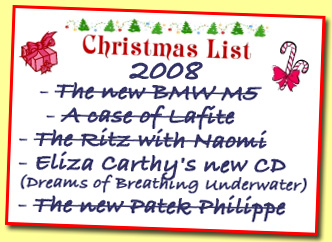 |
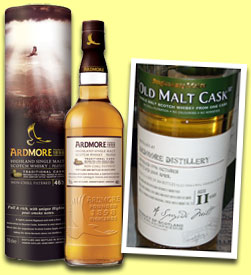 |
TASTING
- TWO ARDMORES
Ardmore
NAS 'Traditional Casks' (46%, OB,
peated, finished in quarter casks,
+/-2008)
 Ardmore Traditional Cask is double
matured, first in usual oak barrels,
and then in much smaller ‘quarter
casks’, like both Laphroaig
and Glenfarclas already did/do.
But are QCs traditional?
Ardmore Traditional Cask is double
matured, first in usual oak barrels,
and then in much smaller ‘quarter
casks’, like both Laphroaig
and Glenfarclas already did/do.
But are QCs traditional? |
| Colour:
gold. Nose: very fresh at first sniffing,
really on peated vanilla-flavoured
porridge if you see what I mean. Not
too sure the oak’s huge sweetness
fits perfectly well here, that is.
Gets fruitier, more on butter pears.
Hints of Demerara sugar and ginger
(speculoos), gentian and liquorice
(allsorts). One of the sweetest very
peated malts. Mouth: very sweet and
rather rich, which once again makes
for a slightly bizarre sweetness/peat
combo. However, it’s a good
dram, with a lot of vanilla again
as well as notes of very ripe peaches.
Finish: medium long, always on this
unusual vanilla/peat duality. More
so, in any case, than with the Laphroaig
QC. Comments: typical modern whisky,
where the oak has its say as such
(spicing), not only as a ‘maturation
facilitator’. SGP:525
– 81 points. |
Ardmore
11 yo 1996/2008 (50%, Douglas Laing,
OMC, selected by LMdW, DL ref 4215,
364 bottles)  Colour: white wine. Nose: I’d
say this is exactly like the Quarter
Cask, minus the very sweet vanilla.
Granted, it’s much more austere
but also cleaner, fresher and less
cloying (not that the QC was cloying
or sickly sweet of course, but…)
More mint, aniseed, wet earth, newly
cut grass, plain chlorophyll and garden
bonfire. Also a tad bubblegummy after
a while, and rather less peaty/smoky
than the QC altogether despite the
pleasant whiffs of cold ashes. Mouth:
a much more typical Ardmore, zesty,
smoky, peaty, nervous and very fresh.
Fresh walnuts, freshly ground pepper,
lemon drops, smoked tea and hints
of cloves. Not very complex but perfectly
‘streamlined’ so to speak.
Finish: medium long, lemony, peppery,
peaty, very zesty. Comments: an elegant,
straightforward young Ardmore without
much wood influence. Good news? SGP:445
– 85 points.
Colour: white wine. Nose: I’d
say this is exactly like the Quarter
Cask, minus the very sweet vanilla.
Granted, it’s much more austere
but also cleaner, fresher and less
cloying (not that the QC was cloying
or sickly sweet of course, but…)
More mint, aniseed, wet earth, newly
cut grass, plain chlorophyll and garden
bonfire. Also a tad bubblegummy after
a while, and rather less peaty/smoky
than the QC altogether despite the
pleasant whiffs of cold ashes. Mouth:
a much more typical Ardmore, zesty,
smoky, peaty, nervous and very fresh.
Fresh walnuts, freshly ground pepper,
lemon drops, smoked tea and hints
of cloves. Not very complex but perfectly
‘streamlined’ so to speak.
Finish: medium long, lemony, peppery,
peaty, very zesty. Comments: an elegant,
straightforward young Ardmore without
much wood influence. Good news? SGP:445
– 85 points. |
| |
|
November
24, 2008 |
|
 |
 |
MM's
Ho-cheng tells us that Kingcar,
the Taiwanese single malt distillery,
have just released their first
single malt bottling. |
 |
It's
called Ka Va Lan single malt
whisky and it's a 2 yo single
malt, bottled at 40%.
Well, maybe
we'll also have La Vis Ker,
Fi Klen Dich or Fra La Egg one
day... ;-) |
| OTHER
NEWS: most scores for
the Malt Maniacs Awards 2008
are in and it seems that the
results will be very surprising
this year. Expect quite some
shudders, a bit of frowning
and, we hope, lots of utter
joy (depending on the competitors,
of course...) Results on Dec
1, as planed. |
|
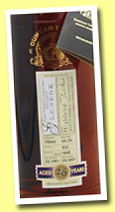 |
TASTING
– TWO GLENESKS |
Glenesk 25 yo 1983/2008 (52.1%, Duncan
Taylor Rare Auld, sherry, cask #4930)
 Glenesk, aka Glen Esk, aka
Hillside, has been silent since 1985
and it’s true that it’s
not too often that we can put our
hands on its whiskies these days,
so thanks to Duncan Taylor for having
bottled several sister casks recently.
Colour: amber. Nose: very powerful,
starting on huge notes of wine and
distillation. Kirsch, maraschino,
a little rubber and quite some meet
sauce (or chicken bouillon for that
matter.) Gets then flintier, with
also quite some gunpowder and burnt
matches as well as notes of plain
oak and burnt sugar (right, caramel).
With water: a big grassiness arises,
with a lot of plain cut grass and
infused green tea, and then more linseed
oil and paraffin, even motor oil.
Mouth (neat): very thick and very
creamy, starting all on orange liqueur
and herbs (coriander) and getting
then more coffeeish. Another coffee-schnapps?
With water: it got half sherried,
half organic. Bitter oranges, strong
coffee (a bit acidic) and peppercorn.
Unusual. Finish: long, with many more
spices now, including various peppers.
Comments: a big multifaceted malt,
not easy-easy (a bit Bartokian if
you see what I mean) but very interesting.
Probably the kind of malt that nobody
makes anymore. SGP:361 –
86 points.
Glenesk, aka Glen Esk, aka
Hillside, has been silent since 1985
and it’s true that it’s
not too often that we can put our
hands on its whiskies these days,
so thanks to Duncan Taylor for having
bottled several sister casks recently.
Colour: amber. Nose: very powerful,
starting on huge notes of wine and
distillation. Kirsch, maraschino,
a little rubber and quite some meet
sauce (or chicken bouillon for that
matter.) Gets then flintier, with
also quite some gunpowder and burnt
matches as well as notes of plain
oak and burnt sugar (right, caramel).
With water: a big grassiness arises,
with a lot of plain cut grass and
infused green tea, and then more linseed
oil and paraffin, even motor oil.
Mouth (neat): very thick and very
creamy, starting all on orange liqueur
and herbs (coriander) and getting
then more coffeeish. Another coffee-schnapps?
With water: it got half sherried,
half organic. Bitter oranges, strong
coffee (a bit acidic) and peppercorn.
Unusual. Finish: long, with many more
spices now, including various peppers.
Comments: a big multifaceted malt,
not easy-easy (a bit Bartokian if
you see what I mean) but very interesting.
Probably the kind of malt that nobody
makes anymore. SGP:361 –
86 points. |
Glenesk
26 yo 1981/2007 (56.9%, Duncan Taylor
Rare Auld, sherry, cask #B933)
 Colour: amber with reddish hues. More
wine influence here it seems. Nose:
this is drier and cleaner than the
1983, with less kirschy notes and
more straight sherry (walnuts, raisins.)
Quite some gunpowder again. We like
this cask better so far. With water:
fantastic notes of wild mushrooms,
wet earth, moss, Havana cigar (very,
very huge), leather and then the same
notes of oil as in the 1983. A wonderful
surprise. Mouth (neat): very, very,
very heavily sherried and concentrated.
Excellently dry, with notes of marc
(marc de Jura or Bourgogne), walnuts,
chewing tobacco, espresso coffee and
even a little tar. Salmiak. With water:
a dry sherry monster. Superb. Finish:
very long, dry and peppery. Comments:
a tad less mindboggling than the 1983,
more classic and more beautiful as
well. Not sure there’s much
distillery character coming through,
but we wouldn’t be able to identify
it anyway ;-). SGP:252 –
89 points (and thanks,
Herbert).
Colour: amber with reddish hues. More
wine influence here it seems. Nose:
this is drier and cleaner than the
1983, with less kirschy notes and
more straight sherry (walnuts, raisins.)
Quite some gunpowder again. We like
this cask better so far. With water:
fantastic notes of wild mushrooms,
wet earth, moss, Havana cigar (very,
very huge), leather and then the same
notes of oil as in the 1983. A wonderful
surprise. Mouth (neat): very, very,
very heavily sherried and concentrated.
Excellently dry, with notes of marc
(marc de Jura or Bourgogne), walnuts,
chewing tobacco, espresso coffee and
even a little tar. Salmiak. With water:
a dry sherry monster. Superb. Finish:
very long, dry and peppery. Comments:
a tad less mindboggling than the 1983,
more classic and more beautiful as
well. Not sure there’s much
distillery character coming through,
but we wouldn’t be able to identify
it anyway ;-). SGP:252 –
89 points (and thanks,
Herbert). |
|
MUSIC
– Recommended
listening: the amazing Steve
Turre at the conch
shells - yes - playing Yussef Lateef's
Morning.mp3
(that was on Turre's 'Ryhtm Within'
CD). A wonderful and very entertaining
piece, please buy Steve Turre's
music! |
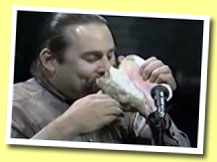 |
| |
|
November
21, 2008 |
|
 |
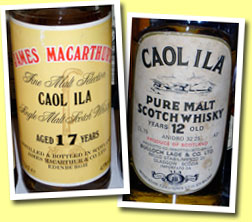 |
TASTING
TWO
OLD CAOL ILAS |
Caol Ila 17
yo (43%, James McArthur, early 1990s)
 Colour: pale gold. Nose: an extremely
unusual Caol Ila! Starts kind of ‘unpeated’
and rather on various kinds of plants
and herbs (hard to pin down –
maybe patchouli, coriander, dried
flowers…) and gets then very
‘coastal’, with big whiffs
of sea air, ‘plate of oysters’,
wet rocks, plain seawater, iodine,
kelp… Prototypical coastal whisky,
‘beyond peat’. Mouth:
much, big at this stage! Huge saltiness
again, a lot of peat, quite some lemon,
various ‘resinous’ herbs
and oils, a lot of pepper… And
then everything maritime again. Oysters,
smoked fish, salt, then more pepper,
more salt, even a little mustard…
It’s really a big peaty whisky
at just 43%. Finish: long, spicier
(wasabi), ultra-dry… . Comments:
wonderful Caol Ila from the mid-1970s,
that is to say from when they had
just restarted the distillery. Yes,
they got it quite right straight away.
SGP:267 – 91 points.
Colour: pale gold. Nose: an extremely
unusual Caol Ila! Starts kind of ‘unpeated’
and rather on various kinds of plants
and herbs (hard to pin down –
maybe patchouli, coriander, dried
flowers…) and gets then very
‘coastal’, with big whiffs
of sea air, ‘plate of oysters’,
wet rocks, plain seawater, iodine,
kelp… Prototypical coastal whisky,
‘beyond peat’. Mouth:
much, big at this stage! Huge saltiness
again, a lot of peat, quite some lemon,
various ‘resinous’ herbs
and oils, a lot of pepper… And
then everything maritime again. Oysters,
smoked fish, salt, then more pepper,
more salt, even a little mustard…
It’s really a big peaty whisky
at just 43%. Finish: long, spicier
(wasabi), ultra-dry… . Comments:
wonderful Caol Ila from the mid-1970s,
that is to say from when they had
just restarted the distillery. Yes,
they got it quite right straight away.
SGP:267 – 91 points. |
Caol
Ila 12 yo (43%, OB for Italy, white
label, rotation 1969)
 Unusual comment on the label: ‘imbottigliato
dalla Bulloch Lade & Co. ltd.
nello stabilimento di Glasgow’
which means ‘bottled in BL&Co’s
Glasgow plant’. Anyway, very
old Caol Ilas distilled in the 1950s
are very rare so we’re really
looking forward to try this one. Nose:
unexpectedly punchy and very medicinal.
Tincture of iodine, mercurochrome,
very fresh almonds, soot, cold ashes
and a little lemon juice. Mouth: nervous,
fresh and lemony, just a tad acidic
(yoghurt). Fine peatiness. Long finish
on fresh almonds. Maybe a little less
‘big Islay’ than the Caol
Ilas that were distilled right before
the distillery got reconstructed (such
as the the 1966s, 1968s or 1969s)
and in that sense closer to the current
production. SGP:336 –
90 points. (and thank
you Luc)
Unusual comment on the label: ‘imbottigliato
dalla Bulloch Lade & Co. ltd.
nello stabilimento di Glasgow’
which means ‘bottled in BL&Co’s
Glasgow plant’. Anyway, very
old Caol Ilas distilled in the 1950s
are very rare so we’re really
looking forward to try this one. Nose:
unexpectedly punchy and very medicinal.
Tincture of iodine, mercurochrome,
very fresh almonds, soot, cold ashes
and a little lemon juice. Mouth: nervous,
fresh and lemony, just a tad acidic
(yoghurt). Fine peatiness. Long finish
on fresh almonds. Maybe a little less
‘big Islay’ than the Caol
Ilas that were distilled right before
the distillery got reconstructed (such
as the the 1966s, 1968s or 1969s)
and in that sense closer to the current
production. SGP:336 –
90 points. (and thank
you Luc) |
| MUSIC
– Recommended
listening: it's Nick who made me
discover the very Brechtian Tiger
Lillies (check their
concert
review). Today, let's have their
Russians.mp3
and then buy their music. They also
have a great DVD called Moutains
of Madness that I heartily recommend. |
 |
| |
|
November
20, 2008 |
|
 |
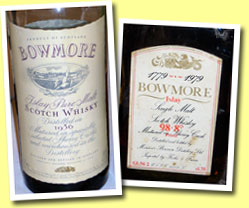 |
TASTING
– TWO RARE OLD BOWMORES |
Bowmore 1956 (43%, OB for Soffiantino,
1980s)  No need to introduce this series I
guess, it put together many of the
best malts ever distilled and bottled
by man in our opinion. Colour: gold.
Nose: otherworldly. Look, let’s
keep this short and sweet: it’s
a class of its own, different from
the Bowmores from the 1960s in the
sense that the latter were fruitier
and less peaty, whilst this displays
the most exceptional combination of
peat smoke and tropical fruits (mostly
citrus this time). A S.T.U.N.N.I.N.G.
combo. Mouth: this is why we’re
into whisky. Grapefruits, spearmint,
peat, lemon marmalade, angelica, woodruff,
high-end walnut liqueur, 3,765 different
spices, 4,623 different fruits, 7,598
different ‘phenolic’ aromas…
Well, I’m sure you get the picture.
Finish: does ‘the peacock’s
tail’ several times in a row,
like the greatest old wines, the most
wonderful peatiness being a permanent
feature. Comments: we had always thought
that straight peat did not stand long
ageing – including bottle ageing
– but this is an example of
a very old whisky (a 30+20, that is
to say 30 years in wood plus 20 years
in glass) that kept all of its peatiness.
Drawback: this makes many recent whiskies
taste a tad, say ridiculous and pretentious.
SGP:666 (devilish
indeed) - 96 points.
No need to introduce this series I
guess, it put together many of the
best malts ever distilled and bottled
by man in our opinion. Colour: gold.
Nose: otherworldly. Look, let’s
keep this short and sweet: it’s
a class of its own, different from
the Bowmores from the 1960s in the
sense that the latter were fruitier
and less peaty, whilst this displays
the most exceptional combination of
peat smoke and tropical fruits (mostly
citrus this time). A S.T.U.N.N.I.N.G.
combo. Mouth: this is why we’re
into whisky. Grapefruits, spearmint,
peat, lemon marmalade, angelica, woodruff,
high-end walnut liqueur, 3,765 different
spices, 4,623 different fruits, 7,598
different ‘phenolic’ aromas…
Well, I’m sure you get the picture.
Finish: does ‘the peacock’s
tail’ several times in a row,
like the greatest old wines, the most
wonderful peatiness being a permanent
feature. Comments: we had always thought
that straight peat did not stand long
ageing – including bottle ageing
– but this is an example of
a very old whisky (a 30+20, that is
to say 30 years in wood plus 20 years
in glass) that kept all of its peatiness.
Drawback: this makes many recent whiskies
taste a tad, say ridiculous and pretentious.
SGP:666 (devilish
indeed) - 96 points. |
Bowmore
'Bicentenary cask strength' (98.8°proof
/56.2%, OB for Fecchio & Frassa,
Italy, cubic bottle, bottled 1979)
 An extremely rare version of the famous
‘1964 Bicentenary’, bottled
for the Italian market at cask strength
instead of 43% - and in an unusual
cubic bottle. This time it’s
rather a ‘15+30’ Bowmore.
Colour: gold. Nose: rather less impressive
than the 1956, but that should come
from the higher strength. Notes of
verbena and chocolate, kumquats and
peat smoke. Actually, maybe we should
have tried this one before the 1956,
but I’m sure water will help
mucho mucho. With water: amazing how
it changed. Much peatier, globally
phenolic, grassy, tarry, meaty (game),
even resinous… Certainly different
from all ‘low strength’
versions of the Bicentenary, and certainly
peatier and ‘wilder’,
even if the markers do show up after
a moment (balsamico, honeydew, camphor,
thyme…) Even after 30 years
in glass, it did need water. Mouth
(neat): how punchy! We’re used
– so to speak – to try
these old Bowmores at much lower strengths
(around 43%) or at 50% (the Blacks)
but this is quite different. Let’s
say this is much more on orange liqueur,
Cointreau, even Parfait Amour (violet
liqueur), with even something a tad
cardboardy. But water should help
again. With water: yes sir, it does.
Here come the kumquats and tangerines,
followed by cough syrup, eucalyptus
drops, mint, fir honeydew and plum
spirit. Finish: long, in the same
vein, with just that faint cardoardiness
coming back at this stage. Comments:
very interesting whisky. It seems
that higher alcohol levels may work
as peat preservatives! Now, the ‘usual’
Bicentenaries at 43% are more common,
but frankly, they’re also tad
better in our opinion. So much for
CS bottlings! SGP:366 - 91
points.
An extremely rare version of the famous
‘1964 Bicentenary’, bottled
for the Italian market at cask strength
instead of 43% - and in an unusual
cubic bottle. This time it’s
rather a ‘15+30’ Bowmore.
Colour: gold. Nose: rather less impressive
than the 1956, but that should come
from the higher strength. Notes of
verbena and chocolate, kumquats and
peat smoke. Actually, maybe we should
have tried this one before the 1956,
but I’m sure water will help
mucho mucho. With water: amazing how
it changed. Much peatier, globally
phenolic, grassy, tarry, meaty (game),
even resinous… Certainly different
from all ‘low strength’
versions of the Bicentenary, and certainly
peatier and ‘wilder’,
even if the markers do show up after
a moment (balsamico, honeydew, camphor,
thyme…) Even after 30 years
in glass, it did need water. Mouth
(neat): how punchy! We’re used
– so to speak – to try
these old Bowmores at much lower strengths
(around 43%) or at 50% (the Blacks)
but this is quite different. Let’s
say this is much more on orange liqueur,
Cointreau, even Parfait Amour (violet
liqueur), with even something a tad
cardboardy. But water should help
again. With water: yes sir, it does.
Here come the kumquats and tangerines,
followed by cough syrup, eucalyptus
drops, mint, fir honeydew and plum
spirit. Finish: long, in the same
vein, with just that faint cardoardiness
coming back at this stage. Comments:
very interesting whisky. It seems
that higher alcohol levels may work
as peat preservatives! Now, the ‘usual’
Bicentenaries at 43% are more common,
but frankly, they’re also tad
better in our opinion. So much for
CS bottlings! SGP:366 - 91
points. |
| MUSIC
– Recommended
listening: no, it's not Pat Metheny,
it's Czech-born jazz guitarist Rudy
Linka who's playing
this Folk
song.mp3 that was on his CD
'Czech It Out'. Better? You decide...
But please buy Rudy Linka's music! |
 |
| |
|
November
19, 2008 |
|
 |
CONCERT
REVIEW by Nick Morgan
JULIE FOWLIS
The Union Chapel, Islington,
London, October 24th 2008 |
|
The Trawlerman is no more. No, Serge,
this is not an elegy for the long-running
demise of the British fishing industry,
but a sad statement of truth. The
Trawlerman, or ‘George’s
Chippy’, as it was sometimes
called, at the top of Upper Street,
very close to the famous Hope &
Anchor (the birthplace in the seventies
of Pub Rock) has closed. George
hung up his apron last year and
now this once no-nonsense sit-innery
has been refashioned, refurbished
and thoroughly gentrified, no doubt
to compete with the likes of Fishworks
and the Fish Shop down the road.
But, modernistic décor notwithstanding,
it still smells like a chippy (as
I’m reminded several hours
later when I put my coat back on
after the gig), even if a plateful
of Haddock and Chips comes in at
near a tenner a piece, rather than
the 1/6d which I’m sure it
should cost. |
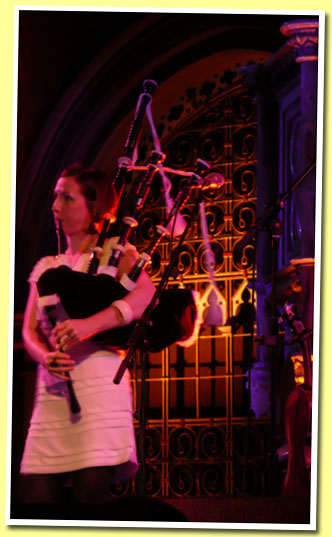 |
|
I can’t help wondering what
the less well-off denizens of the
area, of whom there are many, must
think of this when they come to buy
their Friday night fish-supper. But
it’s nicely cooked and easy
on the palate, there are definitely
some maritime notes, perhaps a zesty
medicinal kick from the …. oops,
sorry Serge, I must have been overdoing
it out here in the City of Gold. Where
was I? Yes, it is pleasing, even if
the chips do have the aura of having
been prepared somewhere many miles
away from where we’re eating
them. Overall verdict – not
bad at all. |
| This
is all by way of saying that we’re
in Islington heading for the Union
Chapel to see Scottish folk-singing
sensation Julie
Fowlis and her band.
Ms Fowlis, who made a brief yet mesmerising
appearance earlier in the year at
the Rogue’s Gallery gig has
made a two-pronged attack on the public
consciousness. Firstly, through the
traditional folk-roots scene (where
she has earned numerous awards and
plaudits), and secondly (and less
likely) via the good offices of everyone’s
favourite middle-aged man’s
rock and roll magazine, Mojo. She
recorded a version of ‘Blackbird’
for a recent ‘White Album’
tribute that the magazine put together,
and such was its reception that it
has now been released as a single.
And perhaps I should add here, before
it’s too late, that Ms Fowlis
sings only in Gaelic. She is a native
of North Uist, in the middle of the
Outer Hebrides, and is proudly taking
her culture and language to the world.
But don’t be put off by the
language bit if, like 99.9999999999999999%
of the world, you are not having the
Gaelic. For Ms Fowlis falls into that
small but captivating category of
singer you would listen to singing
a Hungarian menu if you could, such
is the beauty, clarity, and expressiveness
of her voice. Get the picture? |
| One
actually might have hoped that she
would have chosen to sing without
the use of microphones in the Union
Chapel, whose acoustics no doubt yearn
for a voice such as hers. At least
the sound was perfectly engineered.
Note here too that although Ms Fowlis’s
voice is something of a show-stealer,
she’s no mean hand when it comes
to the accordion, whistle or even
bagpipes. And such an accomplished
performer certainly needs accomplished
accompanists, which she certainly
has. Her husband, Dubliner Eamon
Doorley, plays electric bazouki,
sings, and brings a touch of Irish
humour to the evening, a counterpoint
to the dry wit of Duncan
Chisholm, sometime of Wolfstone
and Blazin’
Fiddles fame, and undoubtedly
one of Scotland’s finest fiddlers.
Tony
Byrne on guitar combines delicate
melodies with driving rhythm, and
bodhrán player Martin
O’Neill simply puts that
often abused instrument onto a different
plane of sophistication and subtlety.
So to repeat, for all that Ms Fowlis’s
voice may be the star, this is a complete
ensemble performance of remarkable
quality. |
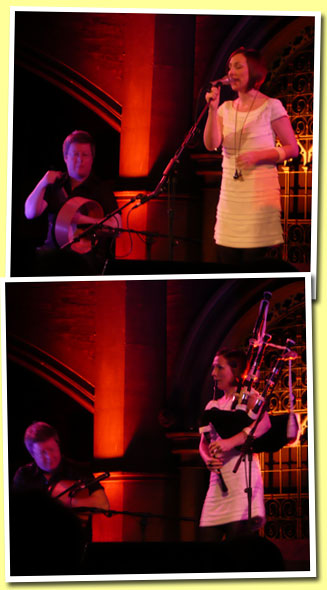 |
| A
shame then that much of it was greeted
with the predictably out-of-time clapping
and foot-stamping that London audiences
(this one has, I observe darkly, something
of the Folk Cub about it) presume
incorrectly to be a perfect accompaniment
for music of this sort. |
| Setlist?
Well that might be a difficult one,
but I do fancy we heard ‘Mo
Ghruagach Dhonn’, ‘Bodaich
Odhar Hoghaigearraidh’, ‘Mo
Bheannachd Dhan Bhaillidh Ur’
….well I’ll stop there,
with the one addition that she did
of course charm everyone with her
version of ‘Blackbird’.
This was an outstanding performance,
justifying all the plaudits that Ms
Fowlis has received, and earning her
a few more. She will no doubt be taking
to the road again next year and I
can only commend you to go and see
her if you get the chance. And in
the meantime I promise you that her
2007 album, Cuilidh, would be a welcome
addition to any Christmas Stocking,
or if you prefer, Holiday Sock. -
Nick Morgan (photographs by Kate) |
| Listen:
Julie
Fowlis' MySpace page (with Blackbird!) |
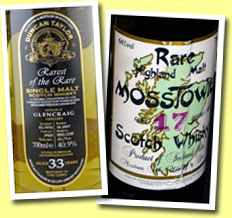 |
TASTING
– TWO MALTS MADE IN LOMOND STILLS
The lomond still was invented in the
1950s at Hiram Walker’s and
was, as we understand it, kind of
a crossbreed between a pot still and
a continuous still. We’ve read
somewhere that these whiskies were
aimed at the US market, which was
asking for very light whiskies at
the time. There’s much more
about Lomond stills by fellow maniac
Lex Kraaijeveld there. |
Glencraig
34 yo 1974/2008 (40.8%, Duncan Taylor
Rarest of the Rare, cask #2929)  Picture shows an earlier 1974 from
last year. Glencraig was distilled
at Hiram Walker’s Glenburgie
Distillery between 1958 and 1981.
Colour: pale gold. Nose: it’s
rather light whisky but the floral
notes are very obvious if not heady.
Whiffs of old roses and lilac. Then
we get quite some oak together with
notes of fresh butter and shoe polish,
the whole getting finally drier and
even a little mineral/lemony. Very
nice, the lighter side of malt whisky.
Mouth: it’s got some character!
Halfway between malt and grain whisky
I’d say, with notes of coconuts,
quite some vanilla, hints of lemon
juice and quite some apple juice as
well. Drops a bit in the middle, lacking
a little body but the freshness is
most enjoyable. Finish: not too long
‘of course’ but very clean
and nicely fruity, with a lot of mint
making a late arrival. What’s
quite impressive is that such light
spirit managed not to get woody after
so many years in oak – even
if it was maybe third or fourth fill.
Comments: very interesting whisky,
of an unusual kind. I think any dedicated
whisky aficionado should try to taste
one of these ‘historical’
Lomond still whiskies one day. SGP:320
– 83 points.
Picture shows an earlier 1974 from
last year. Glencraig was distilled
at Hiram Walker’s Glenburgie
Distillery between 1958 and 1981.
Colour: pale gold. Nose: it’s
rather light whisky but the floral
notes are very obvious if not heady.
Whiffs of old roses and lilac. Then
we get quite some oak together with
notes of fresh butter and shoe polish,
the whole getting finally drier and
even a little mineral/lemony. Very
nice, the lighter side of malt whisky.
Mouth: it’s got some character!
Halfway between malt and grain whisky
I’d say, with notes of coconuts,
quite some vanilla, hints of lemon
juice and quite some apple juice as
well. Drops a bit in the middle, lacking
a little body but the freshness is
most enjoyable. Finish: not too long
‘of course’ but very clean
and nicely fruity, with a lot of mint
making a late arrival. What’s
quite impressive is that such light
spirit managed not to get woody after
so many years in oak – even
if it was maybe third or fourth fill.
Comments: very interesting whisky,
of an unusual kind. I think any dedicated
whisky aficionado should try to taste
one of these ‘historical’
Lomond still whiskies one day. SGP:320
– 83 points. |
Mosstowie
17 yo (66%, Sestante, mid-1980s)
 Mosstowie was distilled at Hiram Walker’s
Miltonduff Distillery between 1964
and 1981. The spirit must have run
at well above 70% vol. when this was
distilled. 66% at 17 years of age,
imagine… Okay, seatbelts fastened,
let’s go. Colour: full gold.
Nose: this is, of course, extremely
punchy but neither totally brutal,
nor spirity as such. You just have
to avoid dipping your nose too deep
into your glass! These very nice floral
notes are well here once again, but
the rest is more towards almondy and
fruity notes (pears), with also hints
of marshmallows (newly opened pack).
A very pleasant grassiness in the
background. With water (and after
a few minutes of rest): great! A very
nice waxiness arises, very ‘old
Highlands’ style, together with
various grassy and herbal notes. Fresh
walnuts, cut grass, hay, then something
curiously smoky/meaty (chicken soup,
or rather pea and bacon chowder) and
finally an unusual mix of parsley
and mint. Much bigger in style than
Glencraig anyway. Mouth (neat): ahem…
Well, one may put this into his mouth
but I think it’s not a good
idea to swallow even one single drop,
except after having carefully ‘reduced’
it using saliva. Way better than Stroh
80, that is. With water: once again,
this is bigger than the Glencraig,
even when reduced down to roughly
40% vol. Liquorice, a little salt,
herbs, unusual notes of cooked green
vegetables, tea… It’s
good. Finish: long and even more vegetal
(notes of white rum and tequila).
Comments: good and very interesting.
Much better than other versions for
Sestante such as the more common 15yo
at 40% vol. SGP:250 - 84 points.
Mosstowie was distilled at Hiram Walker’s
Miltonduff Distillery between 1964
and 1981. The spirit must have run
at well above 70% vol. when this was
distilled. 66% at 17 years of age,
imagine… Okay, seatbelts fastened,
let’s go. Colour: full gold.
Nose: this is, of course, extremely
punchy but neither totally brutal,
nor spirity as such. You just have
to avoid dipping your nose too deep
into your glass! These very nice floral
notes are well here once again, but
the rest is more towards almondy and
fruity notes (pears), with also hints
of marshmallows (newly opened pack).
A very pleasant grassiness in the
background. With water (and after
a few minutes of rest): great! A very
nice waxiness arises, very ‘old
Highlands’ style, together with
various grassy and herbal notes. Fresh
walnuts, cut grass, hay, then something
curiously smoky/meaty (chicken soup,
or rather pea and bacon chowder) and
finally an unusual mix of parsley
and mint. Much bigger in style than
Glencraig anyway. Mouth (neat): ahem…
Well, one may put this into his mouth
but I think it’s not a good
idea to swallow even one single drop,
except after having carefully ‘reduced’
it using saliva. Way better than Stroh
80, that is. With water: once again,
this is bigger than the Glencraig,
even when reduced down to roughly
40% vol. Liquorice, a little salt,
herbs, unusual notes of cooked green
vegetables, tea… It’s
good. Finish: long and even more vegetal
(notes of white rum and tequila).
Comments: good and very interesting.
Much better than other versions for
Sestante such as the more common 15yo
at 40% vol. SGP:250 - 84 points. |
| |
|
November
18, 2008 |
|
 |
| CONCERT
REVIEW by Nick Morgan |
ROBERT 'BILBO' WALKER
Ground Zero Blues Club,
Memphis, Tennessee, October 17th
2008
I
don’t think it was really
Robert
‘Bilbo’ Walker’s
fault. The gig, I mean, not the
name. Not that he was responsible
for that either, what with his daddy,
Big Robert ‘Bilbo’ Walker
having had it and all. So Little
Junior ‘Bilbo’ grew
up to be just plain ‘Bilbo’
when his daddy passed away, a name
which apparently, “he hates”
to this day. As perceptive readers
will note, this account begs a certain
question, but in case you’re
wondering Mr Walker is neither diminutive,
nor does he have furry feet, he’s
not 111 years old (though he certainly
looks a bit more than fifty), I
don’t believe he’s a
burglar, no-one calls him ‘ring-bearer’,
“it like riddles, p’raps
it does, does it?”, and the
only time he disappears is when
he takes a well-earned rest in between
sets. He has, as his son-in-law
tells the Photographer, been travelling
a lot and he’s tired. |
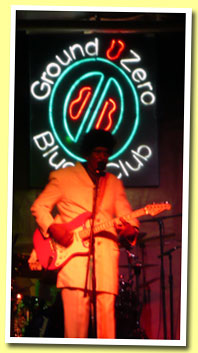 |
| But
like I say it’s not his fault.
Maybe it’s the place. We’re
in the Memphis manifestation of Ground
Zero Blues Club, a cousin of the
joint set up in Clarksdale seven years
ago by, amongst others, Morgan Freeman
(he’s also got a fine
restaurant there – if you
ever visit I thoroughly recommend
the Shrimp and Grits with Onion Gravy
– just perfect!). Ground Zero
occupies the cavernous ground floor
of an ugly modern building and has
the appearance of half snooker hall,
half blues club. The snooker bit is
empty, the blues club half-full. This
could be because, although Mr Walker
is certainly the best gig of the night,
most of the city is at the FedEx Stadium
a few hundred yards away for an evening
of ‘Memphis Madness’ with
college basketball team Memphis
Tigers. It’s not even a
match, just a training session, and
the stadium is packed to the rafters.
Leaving us in the company of a largely
disinterested and easily distracted
audience, working their way solidly
through a fistful of frozen Margaritas,
burgers, deep fried onion rings and
collared greens (well, that’s
what the Photographer was doing anyhow). |
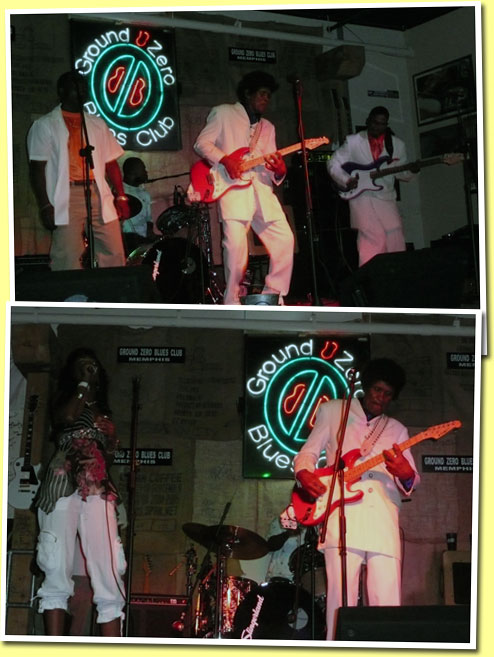 |
| It’s
certainly not his fault, and no one
could be surprised when it all gets
a bit too much for Mr Walker, an impossibly
tall (well, certainly for a hobbit)
and rather lonely- looking figure,
up there on the stage with his trademark
red Stratocaster and white suit. It’s
that bad boy of blues Mr.
Bobby Rush – again. You
see around the bar and hall there
must be ten or more TV screens, and
they’re on (sound down) even
when Mr Walker is playing his engaging
Delta take on primitive rock and roll.
That’s bad enough, but when
all of the males (I was only looking
for the purpose of this review, Serge)
and not a few of the females in the
room are gradually transfixed by the
mesmerising gyrations of a troupe
of Mr Rush’s impossibly-shaped
dancers, it gets, well, a bit too
much. “You here to see Robert
‘Bilbo’ Walker or you
here to see Bobby Rush? I don’t
see no Bobby Rush on this stage. And
if Bobby Rush wants to come here and
try and play his blues with Bilbo
then just let him try, ‘cos
let me tell you this stage belongs
to Robert ‘Bilbo’ Walker
and there ain’t no Bobby Rush
coming here tonight. So you give me
some respect when I’m playing
for y’all here. This is Robert
‘Bilbo’ Walker”.
No, you can’t blame Mr Walker
at all, and it’s sad to observe
that his outburst only resulted in
the screens being switched off for
about ten minutes, such is the North
American penchant for continual visual
stimulation.We left about half way
through the second set, by which time
Mr Walker’s daughters were singing
with him. They’re recording
an album together in California where
he now lives – “they’re
not supporting me, I’m supporting
them”), taking the edge off
his raw Mississippi sound, best heard
on his 1997 album ‘Promised
land’ (with the ubiquitous Mr
Sam Carr on drums). But by then we
had at least witnessed his duckwalk
(I hope I can do that when I’m
in my seventies), and the famous one-handed
guitar solo, a piece of absurd showmanship
steeped in the heritage of the blues.
And I have to say that given another
occasion, no basketball, and no TV
screens, we would rush (oops) to see
him again. - Nick Morgan (photographs
by Kate) |
| Listen:
on Mr
Walker's official web site. |
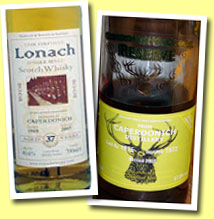 |
TASTING
– TWO RATHER WOODY CAPERDONICHS |
Caperdonich 37yo 1969/2007 (40.6%,
Duncan Taylor, Lonach)
 Colour: white wine. Nose: starts extremely
fresh, floral and fruity, on apple
juice, Parma violets, flowers from
the fields, spearmint and a little
muesli. It’s no big whisky but
it’s far from being silent at
such old age. Goes on with more beer,
ale, porridge and mead as well as
touches of honey and even beef (true
hamburgers – not the poisoning,
sweetened stuff they serve you at
so-called fast food ‘restaurants’).
Very pleasant nose altogether, but
not a big one. Mouth: very soft, maybe
a tad weakish now, dry, spicy and
papery at the same time. Very nice
fruitiness in the background as well
as pleasant notes of herbs and mint
but the wood is a bit overwhelming
here. Finish: medium long, with still
a very nice fruitiness but the heavy
woodiness strikes harder and harder
(tannins, flour, cardboard). Comments:
this must have been great whisky ten
years ago, but I think the wood got
a bit too drying now. One may prefer
other old Caperdonichs by the same
bottler, such as most 1968s in the
Rare Auld range. SGP:470 –
78 points.
Colour: white wine. Nose: starts extremely
fresh, floral and fruity, on apple
juice, Parma violets, flowers from
the fields, spearmint and a little
muesli. It’s no big whisky but
it’s far from being silent at
such old age. Goes on with more beer,
ale, porridge and mead as well as
touches of honey and even beef (true
hamburgers – not the poisoning,
sweetened stuff they serve you at
so-called fast food ‘restaurants’).
Very pleasant nose altogether, but
not a big one. Mouth: very soft, maybe
a tad weakish now, dry, spicy and
papery at the same time. Very nice
fruitiness in the background as well
as pleasant notes of herbs and mint
but the wood is a bit overwhelming
here. Finish: medium long, with still
a very nice fruitiness but the heavy
woodiness strikes harder and harder
(tannins, flour, cardboard). Comments:
this must have been great whisky ten
years ago, but I think the wood got
a bit too drying now. One may prefer
other old Caperdonichs by the same
bottler, such as most 1968s in the
Rare Auld range. SGP:470 –
78 points. |
Caperdonich
1972/2008 (57%, Gordon & MacPhail
Reserve, Holland, cask #1975)  Colour: amber. Nose: loads of wood,
pencil shavings, orange cake, overinfused
tea, sawdust and cinnamon. Wood extract.
With water: much, much better. Great
notes of orange jam, mint, dill and
ham. It got classic now, but at original
strength it’s really heavy.
Mouth: huge, heavy again, concentrated,
extremely tannic. Sticks your tongue
to your palate. Hard to enjoy at natural
strength, let’s add water again.
With water: once again, it got much
better with water, even if it’s
still very tannic. Strawberries, strong
tea. Litres of strong tea actually.
Finish: very long and still very tannic.
Loads of cinnamon. Quince jelly. Comments:
a true monster, for sherry and tannins
lovers exclusively. SGP:481
- 82 points.
Colour: amber. Nose: loads of wood,
pencil shavings, orange cake, overinfused
tea, sawdust and cinnamon. Wood extract.
With water: much, much better. Great
notes of orange jam, mint, dill and
ham. It got classic now, but at original
strength it’s really heavy.
Mouth: huge, heavy again, concentrated,
extremely tannic. Sticks your tongue
to your palate. Hard to enjoy at natural
strength, let’s add water again.
With water: once again, it got much
better with water, even if it’s
still very tannic. Strawberries, strong
tea. Litres of strong tea actually.
Finish: very long and still very tannic.
Loads of cinnamon. Quince jelly. Comments:
a true monster, for sherry and tannins
lovers exclusively. SGP:481
- 82 points. |
| |
|
November
17, 2008 |
|
 |
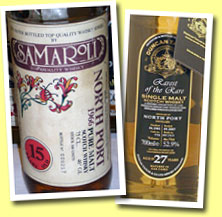 |
TASTING
TWO XLNT NORTH
PORTS |
North Port 15 yo 1966 (46%, Samaroli,
Flowers, 300 bottles)
 Like with many of these old distilleries,
bottlings of North Port can be ‘hit
or miss’ in our opinion, but
that also results in more suspense…
Colour: pale gold. Nose: ho-ho! This
is ‘different’ whisky
indeed. It all starts on superb whiffs
of mutton soup (yeah, no kidding),
Turkish coffee and metal polish and
it goes on with a fab combination
of wood and coal smoke, warm tarmac,
new tyres, burning charcoal and all
things beefy plus dried herbs (many
different). A truly amazing whisky
and a general profile that’s
no more for sure. In that sense, this
is an historic dram. Mouth: fantastico!
All the herbs, citrus fruits, meats
and ‘tiny phenolic things’
of creation. Going on would be pure
maltoporn. Finish: long, complex,
dry, going on with layers and layers
of flavours. Comments: as great as
the old 1964 by Cadenhead’s
that used to be our #1 North Port
until today. SGP:474 - 94
points.
Like with many of these old distilleries,
bottlings of North Port can be ‘hit
or miss’ in our opinion, but
that also results in more suspense…
Colour: pale gold. Nose: ho-ho! This
is ‘different’ whisky
indeed. It all starts on superb whiffs
of mutton soup (yeah, no kidding),
Turkish coffee and metal polish and
it goes on with a fab combination
of wood and coal smoke, warm tarmac,
new tyres, burning charcoal and all
things beefy plus dried herbs (many
different). A truly amazing whisky
and a general profile that’s
no more for sure. In that sense, this
is an historic dram. Mouth: fantastico!
All the herbs, citrus fruits, meats
and ‘tiny phenolic things’
of creation. Going on would be pure
maltoporn. Finish: long, complex,
dry, going on with layers and layers
of flavours. Comments: as great as
the old 1964 by Cadenhead’s
that used to be our #1 North Port
until today. SGP:474 - 94
points. |
North
Port 27 yo 1981/2008 (56.5%, Duncan
Taylor Rarest of the Rare, cask #779)
 This was bottled last month. Colour:
pale gold. Nose: this could have been
very different from the old Samaroli
but it isn’t. It’s probably
a little less complex but we do get
the same huge notes of coffee, smoke,
coal and dried herbs. On the other
hand, this is not meaty at all. Huge
notes of roasted grains as well. Roasted
chestnuts. Keeps evolving, getting
closer to stout and malt extract but
always with a huge smokiness. Mouth:
less ‘pleasantly sharp and dry’
now, and maybe a tad too ‘kirschy’
(raw fruit distillate). Oh well, let’s
see what gives with water: right,
it’s a excellent whisky but
its much less ‘different’
that on the nose, contrarily to what
happened with the 1966. White fruits,
heather honey, a little mint and hints
of pear spirit. Finish: long, getting
a tad more resinous and smoky now.
Comments: superb nose, good palate.
Maybe not as stunning as the Samaroli
but still a wonderful ‘old style’
dram. Great nose, really. SGP:462
– 87 points.
This was bottled last month. Colour:
pale gold. Nose: this could have been
very different from the old Samaroli
but it isn’t. It’s probably
a little less complex but we do get
the same huge notes of coffee, smoke,
coal and dried herbs. On the other
hand, this is not meaty at all. Huge
notes of roasted grains as well. Roasted
chestnuts. Keeps evolving, getting
closer to stout and malt extract but
always with a huge smokiness. Mouth:
less ‘pleasantly sharp and dry’
now, and maybe a tad too ‘kirschy’
(raw fruit distillate). Oh well, let’s
see what gives with water: right,
it’s a excellent whisky but
its much less ‘different’
that on the nose, contrarily to what
happened with the 1966. White fruits,
heather honey, a little mint and hints
of pear spirit. Finish: long, getting
a tad more resinous and smoky now.
Comments: superb nose, good palate.
Maybe not as stunning as the Samaroli
but still a wonderful ‘old style’
dram. Great nose, really. SGP:462
– 87 points. |
|
MUSIC
– Recommended
listening: king of trombone
Bob
Brookmeyer plays the
standard On
the sunny side of the street.mp3
with a lot of hunour. As Zappa wondered,
does humour belong to music? Brookmeyer
says yes! Please buy his music.
|
 |
| |
|
November
15, 2008 |
|
 |
| WHISKY
AND WOMEN -
STORY OF AN EMANCIPATION |
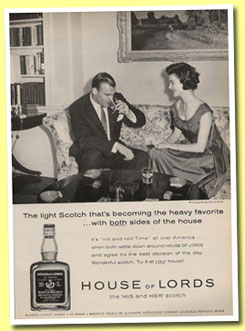 |
 |
Left:
1961 – House of Lords
ad. "The light Scotch that’s
becoming the heavy favorite…
with both sides of the house”.
Women get the right to drink whisky
with their husbands.
Right:
1967 – White Horse
ad. “Today , the one who
wears the pants chooses the Scotch”.
Women also get the right to choose
the house’s favourite tipple. |
 |
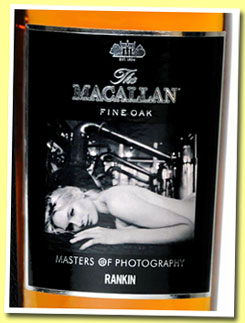 |
Left:
1974 – J&B ad.
“Scotch and the single girl”.
Women – especially when single
- are now completely independent in
their choices.
Right: 2008 –
The Macallan’s new Masters of
Photography 30yo Fine Oak. Women get
the right to, err, pose naked on whisky
labels. It's actually quite beautiful
but a tad too 1980s/Pirelli Calendar
in my opinion, although I’m
sure it’ll work. Old tricks
ALWAYS work, don't they? (Yes, I know,
it's all about fine art photography,
not about naked women.) |
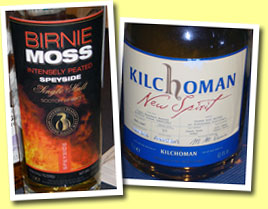 |
TASTING
TWO PEATY
BABIES |
Benriach 'Bernie Moss' (48%, OB, France,
2008)  Bottled at 3 years old (but hey, “as
long as there’s peat”,
may the market say ;-)). Bernie Moss
is the new name for any peated Benriach.
Colour: white wine. Nose: very, very
young and very, very smoky. Porridge
and garden bonfire (grass smoke).
Also hints of wet wool, soot, wet
hay and fresh almonds. Perfectly ‘noseable’
I must say, but mot expectedly, not
really complex. Mouth: quite round,
sweet, smoky and peaty. Smoked apples?
Simpler than on the nose but pleasant.
Hints of salt. Finish: medium long,
smoky, salty and almondy. Comments:
young peat without any ‘coastality’
except for the salty notes on the
palate. A tad gin-ish. Good, simple
peaty whisky. At 44 euros a bottle,
a few more years of maturing would
be welcome, that is… (especially
when compared with all official 10-16yo
Islays.) Is the market ready for 3yo
malt whisky at this price? (yeah,
even peated malt?) SGP:426
– 77 points.
Bottled at 3 years old (but hey, “as
long as there’s peat”,
may the market say ;-)). Bernie Moss
is the new name for any peated Benriach.
Colour: white wine. Nose: very, very
young and very, very smoky. Porridge
and garden bonfire (grass smoke).
Also hints of wet wool, soot, wet
hay and fresh almonds. Perfectly ‘noseable’
I must say, but mot expectedly, not
really complex. Mouth: quite round,
sweet, smoky and peaty. Smoked apples?
Simpler than on the nose but pleasant.
Hints of salt. Finish: medium long,
smoky, salty and almondy. Comments:
young peat without any ‘coastality’
except for the salty notes on the
palate. A tad gin-ish. Good, simple
peaty whisky. At 44 euros a bottle,
a few more years of maturing would
be welcome, that is… (especially
when compared with all official 10-16yo
Islays.) Is the market ready for 3yo
malt whisky at this price? (yeah,
even peated malt?) SGP:426
– 77 points. |
Kilchoman
‘New Spirit’ 2006/2008
(62.4%, OB, casks #446/447)
 Not legally whisky yet, but getting
closer… Colour: white wine.
Nose: huge notes of coffee and coffee
liqueur, as always with high strength
whiskies. As much as we like coffee,
it’s a bit hard to get anything
else (okay, maybe cut apples) so let’s
add water right away. With water:
great! Sure it’s still a little
simple but it’s already quite
far from plain newmake. Wet stones,
ashes, peat smoke, oysters, smoked
fish, vegetables (raw asparagus –
not cooked ones) and iodine. Mouth
(neat): unexpectedly soft, getting
then a tad prickly (lemon juice).
With water: tastes younger than on
the nose but it’s already displaying
good signs of maturity. More apples
and pears than on the nose, notes
of tinned pineapples, grassy peat,
lemons and seafood. Finish: long,
even younger now but clean and zesty.
Comments: this is still baby whisky
(and it’s not sold as ‘mature’
whisky anyway) but it’s already
very pleasant. Somewhat in the same
class as Brittany’s peated version
of Glan ar Mor. SGP:536 –
points: 80-ish (yes, already).
Not legally whisky yet, but getting
closer… Colour: white wine.
Nose: huge notes of coffee and coffee
liqueur, as always with high strength
whiskies. As much as we like coffee,
it’s a bit hard to get anything
else (okay, maybe cut apples) so let’s
add water right away. With water:
great! Sure it’s still a little
simple but it’s already quite
far from plain newmake. Wet stones,
ashes, peat smoke, oysters, smoked
fish, vegetables (raw asparagus –
not cooked ones) and iodine. Mouth
(neat): unexpectedly soft, getting
then a tad prickly (lemon juice).
With water: tastes younger than on
the nose but it’s already displaying
good signs of maturity. More apples
and pears than on the nose, notes
of tinned pineapples, grassy peat,
lemons and seafood. Finish: long,
even younger now but clean and zesty.
Comments: this is still baby whisky
(and it’s not sold as ‘mature’
whisky anyway) but it’s already
very pleasant. Somewhat in the same
class as Brittany’s peated version
of Glan ar Mor. SGP:536 –
points: 80-ish (yes, already). |
|
MUSIC
– Recommended
listening: It's Lester Bowie, Malachi
Favors, Joseph Jarman, Roscoe Mitchell
and Famoudou Don Moye aka the Art
Ensemble of Chicago
and they're playing a Get
In Line.mp3 that's not really
in line (late 1960s). Please buy
these great people's music. |
 |
Check
the index of all entries:
Whisky
Music
Nick's Concert
Reviews
|
 |
 |
 |
|
| |
Best
malts I had these weeks - 90+
points only - alphabetical:
Bowmore
1956 (43%,
OB for Soffiantino, 1980s)
Bowmore
'Bicentenary cask strength' (98.8°proof
/56.2%, OB for Fecchio & Frassa, Italy,
cubic bottle, bottled 1979)
Caol
Ila 12 yo (43%, OB for Italy, white
label, rotation 1969)
Caol
Ila 17 yo (43%, James McArthur, early
1990s)
Mortlach
36 yo 1936 (43%,
Gordon & MacPhail for Pinerolo, rotation
1973)
Mortlach
35 yo 1936 (43%, Gordon & MacPhail
for Pinerolo, rotation 1972)
North
Port 15 yo 1966 (46%, Samaroli, Flowers,
300 bottles)
Tomatin
42 yo 1965/2008 (50.0%, Duncan Taylor
Rare Auld, Germany, cask #20939)


|
| |
|
|



